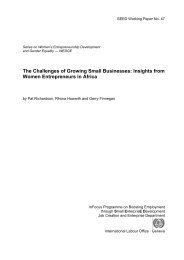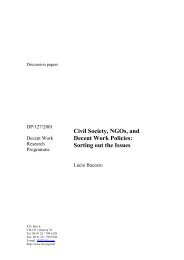Nepal Trafficking in Girls With Special Reference to Prostitution: A ...
Nepal Trafficking in Girls With Special Reference to Prostitution: A ...
Nepal Trafficking in Girls With Special Reference to Prostitution: A ...
You also want an ePaper? Increase the reach of your titles
YUMPU automatically turns print PDFs into web optimized ePapers that Google loves.
A Rapid Assessment<br />
III. Processes of <strong>Traffick<strong>in</strong>g</strong><br />
3.1 The Magnitude<br />
of Child <strong>Traffick<strong>in</strong>g</strong><br />
“The study of child traffick<strong>in</strong>g is risky. The<br />
previous attitudes and the present problem<br />
are different. Previously it was the problem of<br />
our ethnic group (Tamang) of Nuwakot and<br />
S<strong>in</strong>dhupalchowk. Now it is the problem<br />
throughout <strong>Nepal</strong>, and of all the castes and<br />
communities. The concept was that those<br />
trafficked are Tamangs and from the villages,<br />
but it is now <strong>in</strong> the cities also. Not only<br />
females are trafficked but males <strong>to</strong>o. Previously<br />
traffick<strong>in</strong>g was largely <strong>in</strong> India but now<br />
traffick<strong>in</strong>g takes place with<strong>in</strong> the country,<br />
<strong>in</strong><strong>to</strong> India and other countries,” says a<br />
S<strong>in</strong>dhupalchowk social worker.<br />
Estimat<strong>in</strong>g the <strong>in</strong>cidence of child traffick<strong>in</strong>g is<br />
risky bus<strong>in</strong>ess. Yet it is essential <strong>to</strong> make a rough estimate<br />
of the number of young girls who are trafficked<br />
for commercial exploitation each year. The <strong>in</strong>formation<br />
collected dur<strong>in</strong>g the Rapid Assessment fieldwork<br />
provides some clues <strong>to</strong> help determ<strong>in</strong>e the <strong>in</strong>cidence<br />
of children trafficked <strong>in</strong> one year.<br />
Important <strong>in</strong>formation was collected <strong>in</strong> a small-scale<br />
survey conducted by a local NGO, Society Protection Youth<br />
Club, <strong>in</strong> Ichowk VDC of S<strong>in</strong>dhupalchowk District. Although<br />
the area covered is limited <strong>to</strong> only four wards, the results<br />
seem quite reliable <strong>in</strong> view of the team composition and the<br />
<strong>in</strong>tensive work done dur<strong>in</strong>g the study 1 . In the four wards<br />
studied, 61 households (20 %) were affected. Dur<strong>in</strong>g a period<br />
of four years, 73 children were trafficked from the affected<br />
households. This translates <strong>to</strong> an average of five children<br />
trafficked from each Village Development Committee<br />
<strong>in</strong> the 26 most traffick<strong>in</strong>g-prone districts each year.<br />
Useful <strong>in</strong>formation was also collected from<br />
“Helpl<strong>in</strong>e”— a local NGO <strong>in</strong> Gongabu Bus Park. <strong>With</strong><strong>in</strong><br />
a s<strong>in</strong>gle year, this NGO rescued 48 girls who were about<br />
<strong>to</strong> be trafficked. The practice of traffick<strong>in</strong>g seems <strong>to</strong> also<br />
extend <strong>to</strong> eleven districts that are not listed among the<br />
26 traffick<strong>in</strong>g-prone districts identified by the M<strong>in</strong>istry<br />
of Women, Children and Social Welfare 2 . These districts<br />
are Tanahun, Surkhet, Kapilbastu, Rautahat, Bara,<br />
Tehrathum, Okhaldhunga, Bardia, Lamjung, Bhojpur<br />
and Jumla.<br />
F<strong>in</strong>ally, one hundred vulnerable households (the<br />
same as the 100 vulnerable girls mentioned on page<br />
13), were <strong>in</strong>terviewed dur<strong>in</strong>g the RA fieldwork, partly<br />
<strong>to</strong> <strong>in</strong>vestigate the number of girls trafficked from the<br />
respective villages dur<strong>in</strong>g the previous year. In addition<br />
<strong>to</strong> the results from the NGO Helpl<strong>in</strong>e above, this<br />
survey data revealed that 53 girls were trafficked from<br />
eleven VDCs and three girls were trafficked from 38<br />
households <strong>in</strong> three municipalities. This <strong>in</strong>formation<br />
also <strong>in</strong>dicated that the average flow of trafficked girls<br />
<strong>in</strong> one year from one VDC <strong>in</strong> the 26 most traffick<strong>in</strong>gprone<br />
districts is roughly five girls.<br />
Assum<strong>in</strong>g that an average of five girls are trafficked<br />
each year from VDCs <strong>in</strong> the 26 most traffick<strong>in</strong>g-prone<br />
districts; and that half that number (2.5 girls)<br />
are trafficked from VDCs <strong>in</strong> the eleven additional traffick<strong>in</strong>g-prone<br />
districts identified; and that an average<br />
of one girl is trafficked from 38 households <strong>in</strong> three<br />
municipalities, an estimated 12,000 children are trafficked<br />
every year from <strong>Nepal</strong>.<br />
Due <strong>to</strong> the scant <strong>in</strong>formation and broad nature<br />
of the assumptions, the figure must be read with caution.<br />
It is obvious that more research is needed. Yet<br />
clearly the use of local data and alternative means of<br />
data gather<strong>in</strong>g can be of great value when estimat<strong>in</strong>g<br />
the <strong>in</strong>cidence of traffick<strong>in</strong>g <strong>in</strong> <strong>Nepal</strong>.<br />
3.2 His<strong>to</strong>rical Aspects of <strong>Traffick<strong>in</strong>g</strong><br />
The his<strong>to</strong>ry of traffick<strong>in</strong>g <strong>in</strong> <strong>Nepal</strong> is yet <strong>to</strong> be<br />
written. However, local his<strong>to</strong>ry <strong>in</strong>dicates that traffick<strong>in</strong>g<br />
has been associated with poverty, social exclusion<br />
and ignorance, but associated with the practice<br />
of slavery and the bonded labour system. Understand<strong>in</strong>g<br />
specific contemporary processes of traffick<strong>in</strong>g <strong>in</strong><br />
<strong>Nepal</strong> necessitates <strong>in</strong>-depth knowledge of the his<strong>to</strong>rical<br />
processes of traffick<strong>in</strong>g – and much more attention<br />
than the scant his<strong>to</strong>rical aspects recounted <strong>in</strong> the<br />
follow<strong>in</strong>g paragraphs.<br />
The orig<strong>in</strong> of traffick<strong>in</strong>g <strong>in</strong> S<strong>in</strong>dhupalchowk and<br />
Nuwakot Districts is associated with the his<strong>to</strong>rical<br />
relationship between the rul<strong>in</strong>g H<strong>in</strong>du castes of<br />
Kathmandu and the <strong>in</strong>digenous Tamang communities<br />
<strong>in</strong> the surround<strong>in</strong>g area. His<strong>to</strong>rically, the Tamangs<br />
were socially deprived, economically exploited and<br />
politically excluded. The rul<strong>in</strong>g class kept young<br />
Tamang concub<strong>in</strong>es <strong>in</strong> their palaces and mansions.<br />
1 5

















